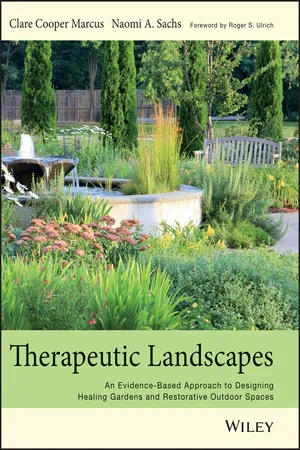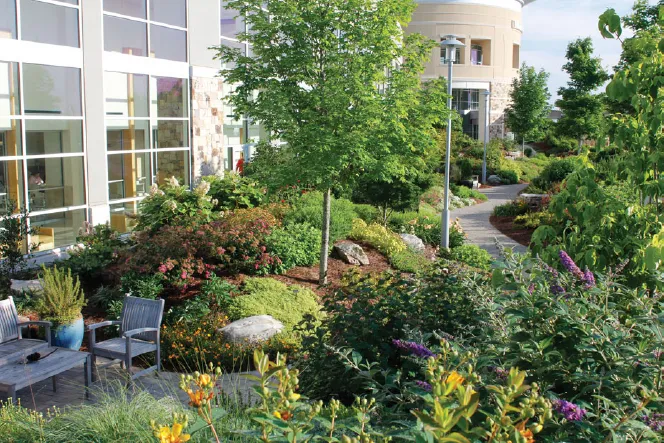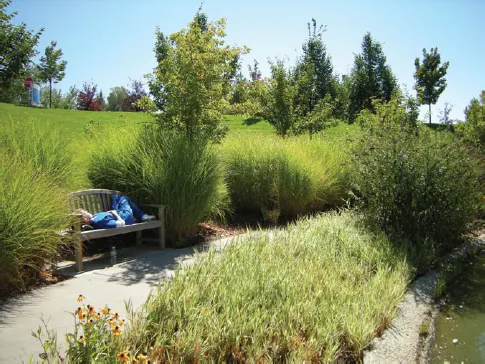
eBook - ePub
Therapeutic Landscapes
An Evidence-Based Approach to Designing Healing Gardens and Restorative Outdoor Spaces
- English
- ePUB (mobile friendly)
- Available on iOS & Android
eBook - ePub
Therapeutic Landscapes
An Evidence-Based Approach to Designing Healing Gardens and Restorative Outdoor Spaces
About this book
This comprehensive and authoritative guide offers an evidence-based overview of healing gardens and therapeutic landscapes from planning to post-occupancy evaluation. It provides general guidelines for designers and other stakeholders in a variety of projects, as well as patient-specific guidelines covering twelve categories ranging from burn patients, psychiatric patients, to hospice and Alzheimer's patients, among others. Sections on participatory design and funding offer valuable guidance to the entire team, not just designers, while a planting and maintenance chapter gives critical information to ensure that safety, longevity, and budgetary concerns are addressed.
Frequently asked questions
Yes, you can cancel anytime from the Subscription tab in your account settings on the Perlego website. Your subscription will stay active until the end of your current billing period. Learn how to cancel your subscription.
No, books cannot be downloaded as external files, such as PDFs, for use outside of Perlego. However, you can download books within the Perlego app for offline reading on mobile or tablet. Learn more here.
Perlego offers two plans: Essential and Complete
- Essential is ideal for learners and professionals who enjoy exploring a wide range of subjects. Access the Essential Library with 800,000+ trusted titles and best-sellers across business, personal growth, and the humanities. Includes unlimited reading time and Standard Read Aloud voice.
- Complete: Perfect for advanced learners and researchers needing full, unrestricted access. Unlock 1.4M+ books across hundreds of subjects, including academic and specialized titles. The Complete Plan also includes advanced features like Premium Read Aloud and Research Assistant.
We are an online textbook subscription service, where you can get access to an entire online library for less than the price of a single book per month. With over 1 million books across 1000+ topics, we’ve got you covered! Learn more here.
Look out for the read-aloud symbol on your next book to see if you can listen to it. The read-aloud tool reads text aloud for you, highlighting the text as it is being read. You can pause it, speed it up and slow it down. Learn more here.
Yes! You can use the Perlego app on both iOS or Android devices to read anytime, anywhere — even offline. Perfect for commutes or when you’re on the go.
Please note we cannot support devices running on iOS 13 and Android 7 or earlier. Learn more about using the app.
Please note we cannot support devices running on iOS 13 and Android 7 or earlier. Learn more about using the app.
Yes, you can access Therapeutic Landscapes by Clare Cooper Marcus,Naomi A Sachs in PDF and/or ePUB format, as well as other popular books in Architecture & Urban Planning & Landscaping. We have over one million books available in our catalogue for you to explore.
Information
Chapter 1
Introduction
Having spent many weeks in the hospital left an indelible imprint on the way I experience pain, suffering, and loss within the recognized healthcare environment. Surely this fear and anxiety that one feels in this controlled and somewhat clinical building can leave one feeling more vulnerable, fragile, and scared. Just by being outside and with nature, to smell and touch the plants, reduced the depression and dread. I think more positive thoughts, am hopeful, and if I cry I feel the plants understand and do not judge or cringe.
Mariane Wheatley-Miller, personal communication, 2013
HOSPITALS AND OTHER HEALTHCARE FACILITIES are some of the most difficult places for people to be. Regardless of the physical setting, they are almost invariably environments where people face a high degree of stress. Patients may be experiencing physical or emotional pain; visitors, in an alien and, for many, a threatening environment, are worried about a loved one or close friend. Healthcare providers, in many cases dealing with life and death on a daily basis, are under an enormous amount of pressure. Their hours are long and their workload is taxing.
Since the mid-1990s there has been an increasing emphasis on a patient-centered approach in healthcare and a growing understanding of the importance of evidence-based design (Cama 2009; Frampton, Gilpin, and Charmel 2003). Hospital interiors have largely changed from the white, clinical settings of decades ago to more colorful—sometimes even hotel-like—environments. Nursing homes, renamed assisted-living facilities, have largely left behind their depressing reputation and are being reborn as warm, homelike settings. The environmental needs of specific patients, such as those with Alzheimer’s disease, are increasingly understood. In short, there has been a revolution in the provision of healthcare and the recognition that the physical environment matters to people’s health and well-being and that the health and well-being of the whole person needs to be addressed rather than just the disease.
Along with these beneficial changes to healthcare buildings, there has been a growing recognition that the whole environment—including outdoor space—matters (fig. 1.1). A significant body of research confirms and sheds new light on what many people have known intuitively: that connection with nature is beneficial—even vital—for health. Walking in the woods, sitting on a park bench, tending the soil in one’s garden, and even watching the colors and movements of nature from indoors are all passive and active ways to connect with the natural world. They awaken our senses, encourage physical movement and exercise, facilitate social connection, reduce stress and depression, and elicit positive physiological and psychological response. Healthcare facilities—from hospitals to specialized medical settings to assisted-living and retirement communities—are striving to incorporate specially designed outdoor spaces that can support the health and well-being of patients, residents, visitors, and staff (fig. 1.2).
1.1 The trend toward patient-centered care continues to grow. Healthcare facilities such as the Northeast Georgia Medical Center, in Gainesville, incorporate restorative gardens into the master plans from the beginning of the design process. The Wilheit-Keys Peace Garden offers physical access to nature outside of the building and visual access from inside. Designer: The Fockele Garden Company.
Copyright, The Fockele Garden Company

1.2 Walking paths and benches for rest—even for stretching out to take a nap—provide a restorative environment for patients, visitors, and staff. The gardens of McKay Dee Hospital, in Ogden, Utah, are also open to the public and are thus an example of “preventive care” through community-centered design.
Photo by Chris Garcia

Professional magazines are increasingly mentioning praiseworthy hospitals with healing gardens or views to nature. Excellent books have been published recently that focus specifically on healthcare outdoor space (Rodiek and Schwarz 2006, 2007; Pollock and Marshall 2012). However, it is rare that journals and magazines read by designers review such books or feature articles on healthcare outdoor space. Sadly, excellent books and monographs on healthcare building design often pay scant attention to outdoor spaces. Building plans are depicted with white expanses around them as if they are floating in space.
While the evidence for the importance of access to nature is there—and growing—the actual provision of appropriate outdoor space in healthcare facilities is often less than adequate, with limited “green nature,” unmet needs for privacy and “getting away,” even poor provision of the most basic needs, such as ease of access, comfortable seating, safe walking surfaces, protection from the sun, and so on.
The goal of this book is to focus critical attention on healthcare outdoor space, to emphasize the importance of evidence-based design, to highlight exemplary case studies, and to present research-based guidelines to inform clients and designers of restorative outdoor spaces. The aim is to address two key groups of readers: the clients and funders of healing spaces and the designers (principally landscape architects) who will translate client needs into an actual environment. If clients and funders understand more about the requirements and goals of a healing garden, they can more easily communicate with the designer. If designers understand more about the research on which to base their decisions, they are more likely to meet the goals of their clients—those who provide the funding and the users who will eventually benefit from the garden (fig. 1.3).
1.3 Native plantings at Kent Hospital in Warwick, Rhode Island, create a beautiful entrance. Designer: Wellnesscapes.
Photo courtesy of Thomas Benjamin, Wellnesscapes.com, on behalf of Kent Hospital

With an audience of two quite different sets of “actors,” it is inevitable that some parts of this book will speak more to one than the other. For example, some sections of the chapter on planting and maintenance may be basic knowledge for an experienced landscape architect but new and useful information for a client. The detailed design guidelines are principally aimed at the practicing designer and may be of less importance to the client or philanthropic donor. Chapters on horticultural therapy and participatory design may provide new information for many readers. The case studies of exemplary gardens throughout document existing best practices and will, the authors hope, inspire anyone using this book.
The core of the book consists of the general design guidelines presented in chapter 6. These are research-informed recommendations that need to be followed in any kind of healthcare outdoor space, whether it is a courtyard or a roof garden, whether it is at an acute-care hospital or a residential facility for the frail elderly. Beyond these basic guidelines, specific guidelines must also be followed for certain patient groups. These are explained in chapters 7 through 14—gardens for ill children, those with cancer, the mentally ill, Alzheimer’s patients, the frail elderly, returning veterans, rehabilitation patients, and those in hospice.
Different terms have emerged to refer to outdoor spaces in healthcare, and two different types can be recognized. A healing, therapeutic, or restorative garden (these terms are used interchangeably in this book) is one that users, whether residents or visitors, experience any way they want: to sit, walk, look, listen, talk, meditate, take a nap, explore. Therapeutic benefits are derived from just being in the garden. No staff is necessary, except for maintenance. Such a garden might be found at an inpatient acute-care hospital, a residential facility for the frail elderly, a hospice, or an outpatient clinic.
In an enabling garden, by contrast, activities are led by a professional horticultural therapist (HT), occupational therapist (OT), physical therapist (PT), and other allied professionals in collaboration with other clinical staff. The HT might engage recovering stroke victims in weeding, watering, and repotting plants; the PT or OT might help someone with a broken limb by encouraging reaching, grasping, and exercising. Therapeutic benefits are derived from hands-on activities and exercise in the garden (fig. 1.4). Such a garden is likely to be found at a rehabilitation hospital, some mental and behavioral health facilities, and some children’s hospitals.
1.4 A veteran transplants seedlings into a larger pot at Gardening Leave in Auchincruive, Scotland.
Courtesy of Gardening Leave Limited

For the purposes of this book, “nature” is defined quite broadly, and while largely referring to vegetation, it also refers to wildlife, water, stone, the weather, sky, clouds, wind, and sun. “Access to nature” includes actual passive and active, indoor and outdoor engagement with nature through any or all of the senses (fig. 1.5).
1.5 Great spangled fritillary on butterfly weed.
Photo from www.henrydomke.com.

Indoor contact with nature can include looking out at nature through a window; viewing nature imagery (still and moving pictures); seeing, touchin...
Table of contents
- Cover
- Contents
- Title
- Copyright
- Foreword
- Acknowledgments
- Chapter 1: Introduction
- Chapter 2: History of Hospital Outdoor Space
- Chapter 3: Theory, Research, and Design Implications
- Chapter 4: Types and Locations of Therapeutic Landscapes in Healthcare
- Chapter 5: The Participatory Design Process
- Chapter 6: General Design Guidelines for Healthcare Facilities
- Chapter 7: Children’s Hospital Gardens
- Chapter 8: Gardens for Cancer Patients
- Chapter 9: Gardens for the Frail Elderly
- Chapter 10: Gardens for People with Alzheimer’s and Other Dementias
- Chapter 11: Hospice Gardens
- Chapter 12: Gardens for Mental and Behavioral Health Facilities
- Chapter 13: Gardens for Veterans and Active Service Personnel
- Chapter 14: Rehabilitation Gardens
- Chapter 15: Restorative Gardens in Public Spaces
- Chapter 16: Horticultural Therapy and Healthcare Garden Design
- Chapter 17: Planting and Maintaining Therapeutic Gardens
- Chapter 18: Therapeutic Landscapes and Sustainability
- Chapter 19: The Business Case and Funding for Therapeutic Gardens
- Chapter 20: Evaluation of Therapeutic Gardens
- Index